I’ve been learning how to cold smoke for decades. I thought it would be hard to understand initially, but one must see it as a craft rather than a recipe. I mean that it takes experience, observation, and attention.
Below, I hope to explain cold smoking and slightly demystify the subject. With some essential equipment and knowledge, cold smoking can be incredibly satisfying. I’ve got the how-to, different ways to make the cold smoke, areas to smoke in, and a step-by-step guide below.
Plenty of nuances when it comes to cold smoking, and that is where I can add more than their general knowledge approach, the inner workings of the craft.
Having airflow and ‘cold smoke’ creating a complex flavor from passing around the meat, which will assist in drying and taste. Humidity at higher levels also helps in the process, which is the theory.
Why Cold Smoke Meat
Here are some examples of various cold-smoking I’ve used and learned about.
Cold smoking is traditionally used for preservation but also for another complex angle of flavor.
Some, like Traditional Cold-Smoked Bacon, are often considered irresistible because of the salt, the sweetness of the meat (or the addition of sweetness), smoke, and fat!
To clarify, Hot Smoking, whether with direct or indirect heat, always involves cooking the meat to a finished internal temperature. Cold Smoking involves drying the meat with cool smoke around it for flavor and protection.
Covering many aspects of cold-smoking, I made this video below also.
The non-cured options for cold-smoked foods will be elaborated on another page here. Cold-smoking foods that aren’t cured meat are an excellent way to learn and develop a feel for the craft of cold-smoking food.
Ingredients
Salt without additives is the only base ingredient for cold-smoking cured meat, here is an article on what salt I wrote explaining more.
Optional ingredients like sodium nitrate/nitrite can also be used, I’ll link to a comprehensive article I wrote here.
Quality of the Meat
Fresh meat handled properly should harbor less unwanted spoiling bacteria.
You do not want dry/wet aged meat; fresh meat is always best. That has been handled with care and refrigerated.
I have used frozen pork belly for bacon, which turned out great. Other aspects of quality, traceability and care are what I seek in my meat.
Equipment
Cold smoking equipment has two aspects: a device for generating the cold smoke and an area/chamber for capturing it.
You have an area like a hooded grill that you could retrofit with a device. I’ll go over many of the options below.
Devices for Cold Smoke
There is a simple approach: You can use minimalistic materials, like a lump of charcoal or two sprinkled with woodchips.
Pellet Tube & Maze Style Smoke Devices
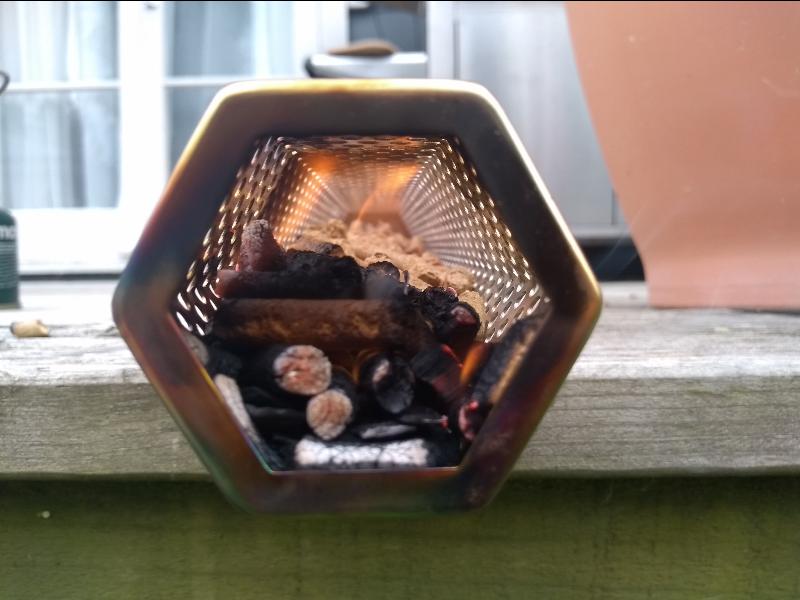
Pellet tube smokers work very similarly to each other. You light one end, and it starts smoking—pretty simple. However, because it isn’t a controlled form of burning, it can be a little hit-and-miss. For example, sometimes I find the pellets stop burning.
Simply use pellets or woodchips and let the flame get to 3″ or about 70mm for 3 minutes, then blow it out and place horizontally in smoking area.
I use a pellet tube smoker on my hooded grill, I’ll write some more about retrofitting a area for cold smoking below.
A pellet tube or maze might not generate enough smoke to fill a smokehouse or larger cabinet, depending on its size and design.
I made this video below with some tips on using a pellet tube smoker.
Smoke Generator
Using the Venturi effect, the air pump blows into the smoking chamber, and the air pipe sucks the smoke from the burning area.
It has a variable controller, so you can control how much smoke is generated and how it burns.
Depending on the wood you use, this means you have more control over the cold smoking project.
These can come in a range of sizes. I find they can create a good amount of smoke. I’ve extensively used them in my gas grill, vertical smoker, wine barrel,and kettle smoker.

Some smoke generators can handle larger chips and chunks of wood, while others are more suited to pellet wood fuels. I’ve tried using the unrecommended wood sizes a few times, but it becomes annoying because you must relight or clean out the tubes often. If I were you, I would avoid this experimental behavior.
This is a ‘cool’ (cold smoke) invention. I have been using it for many years. My smoke generator came with a drill bit. You can then make a hole and use a nut and thread to mount the smoker in many locations.
The smoke generator has an adjustable air pump to adjust the smoke level being pumped in.
Here is a review of the Smokai I did; it’s a solid, consistent, clean smoker. It’s a cold smoker, but it can also boost smoke for a hot smoker or low and slow smoker.
A small air
The key to smoke generators working effectively is to use good, dry wood that’s right-sized for the device. Some generators prefer chunkier-sized wood, while others prefer some dimensions or pellets.
Retrofitting a Device
With one of the above devices, you can potentially retrofit to a chamber/area you already have. The heat generated by the cold smoking device has to be far enough from the chamber so the temperature does not exceed 76°F/30°C – ideally under 68°F/20°C.
Here are some recommendations for what device could be retrofitted onto something you already have.
| Existing Device | Recommended Retrofit |
|---|
| Hooded Grills | Smoker Generator, Pellet Tube Smoker/Maze |
| Ceramic Egg Grill, Smoker | Smoker Generator |
| Fridge | Smoker Generator |
| Untreated Wood – Beehive | Smoker Generator |
| Kettle, Drum, Barrel Smoker | Smoker Generator, Pellet Tube Smoker/Maze |
| Pellet Grill Smoker | Smoker Generator |
Smoking Wood
Certain woods are suitable for cold smoking (or hot); often, these are not evergreen and deciduous (simply trees that lose leaves in winter).
The wood shape may vary depending on your cold-smoking device.
Compared to oak or pecan, Hickory has completely different smoke flavor profiles.
I wrote another article about what smoking wood to use here.
This is relevant for different devices since some will need specific sizes, and you can not source the wood yourself.
Lighter hardwoods like apple and cherry are my preference for cold smoking. Heavier or stronger woods like mesquite will create a deeper, more robust flavor. Ideally, I like to mix them. Sometimes, I use an 80:20 ratio of light to stronger wood.
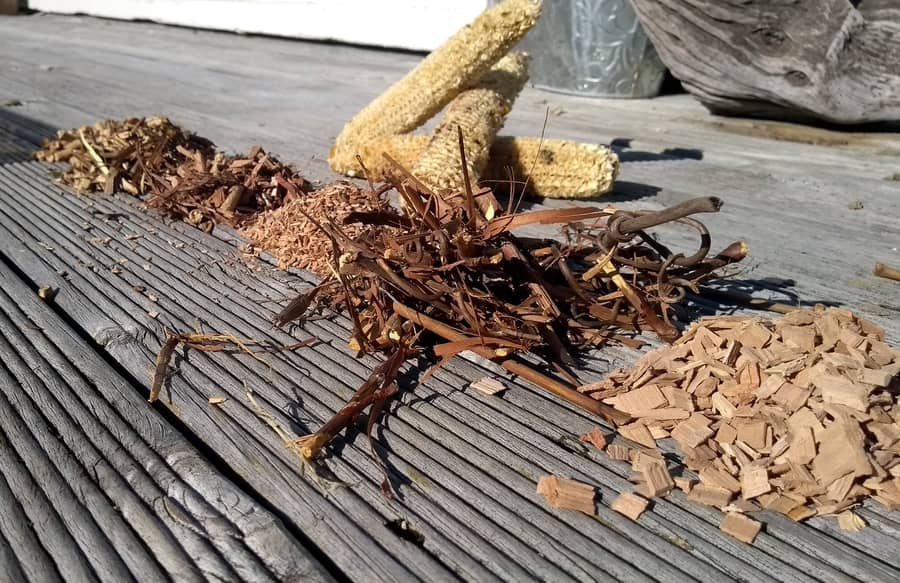
For more wood selection, I wrote easy universal woods in this post.
Areas/Chambers for Device
As mentioned above, retrofitting is often an option, or you can build something out of brick, earth masonry, or wood.
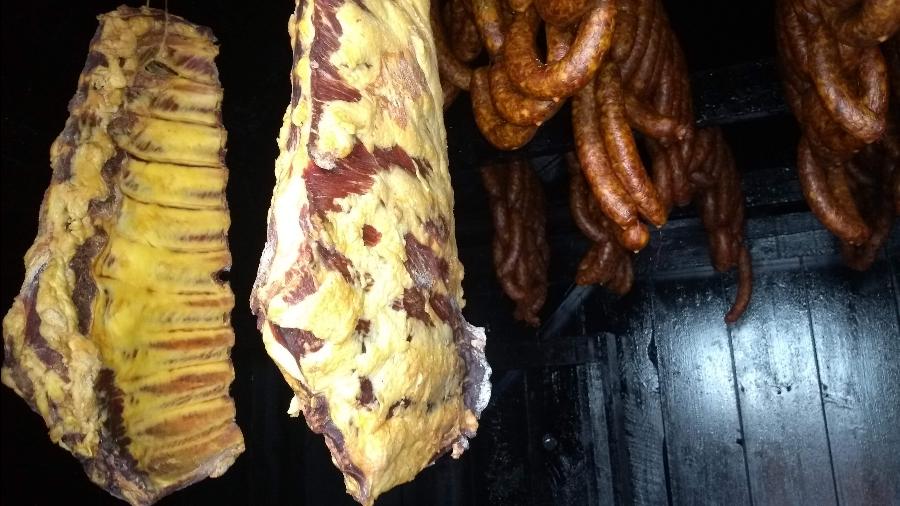
Most designs I have seen have two chambers.
- An area where wood is smoking & smoldering
- food or meat area where meat can be hung or on racks
A pipe or some connection is made so the smoke can travel to the smoking food area. Because the fire/wood is in a different area, this keeps the temperature below the all-important 30°C or 86°F, generally speaking.
Another design I’ve seen was based on the size of the chamber; he used it in the cooler months.
A Dutch butcher who taught me many years ago. He had a huge metal storage tank with double doors. He would make a pile of sawdust/shavings below the meat and light it with a blow torch (wood was untreated hardwoods like mahogany from a furniture maker). The temperature was consistently low because it was 4 feet/1.5 meters below where the meat was hung, temperature always around 10°C/50°F.
I wrote another article about DIY Cold Smokers here that goes into options.
Wooden Cabinet Smoker/Smokehouse—Although a cabinet or box can be designed in many ways, it is important to incorporate a hanging system into the structure; smoking causes more exposure.
Masonry Bricks are a much more permanent fixture, but they can also make a great, long-lasting smoker.
Bricks can also be used for a tunnel style with a burning/smoke area – tunneling through to the smoking chamber.
Hanging & Racks
It does come down to the design. Traditionally, fish fillets and salami are hung. But if you have racks in the smoker, it can also work. However, gravity does assist the drying more effectively I’ve discovered.
Fish is a little more complicated since it can slip off if not hung with some thought (I’ve learned from any fish falling in the chamber off hooks, for instance).
Rods, S hooks, twine, and racks can all be used somehow. Below are some examples of hanging.
One advantage of being hung is that smoke can more easily surround the meat.
When it comes to smokehouses with offset smoking areas or smoke generators, I find myself checking every hour or two to make sure the smoke is still being generated. Sometimes, a smoke generator will go out and need igniting again.
How to Cold Smoke Meat
For a consistent result, there are subtleties and nuances. I’ll elaborate on each of these steps:
- Salt Curing
- Form pellicle on exterior
- Setup a cold smoker
- Hang, Cold smoke, and Monitor
- Cover, Res,t and Refrigerate
1. Salt Curing – Dry or Wet curing
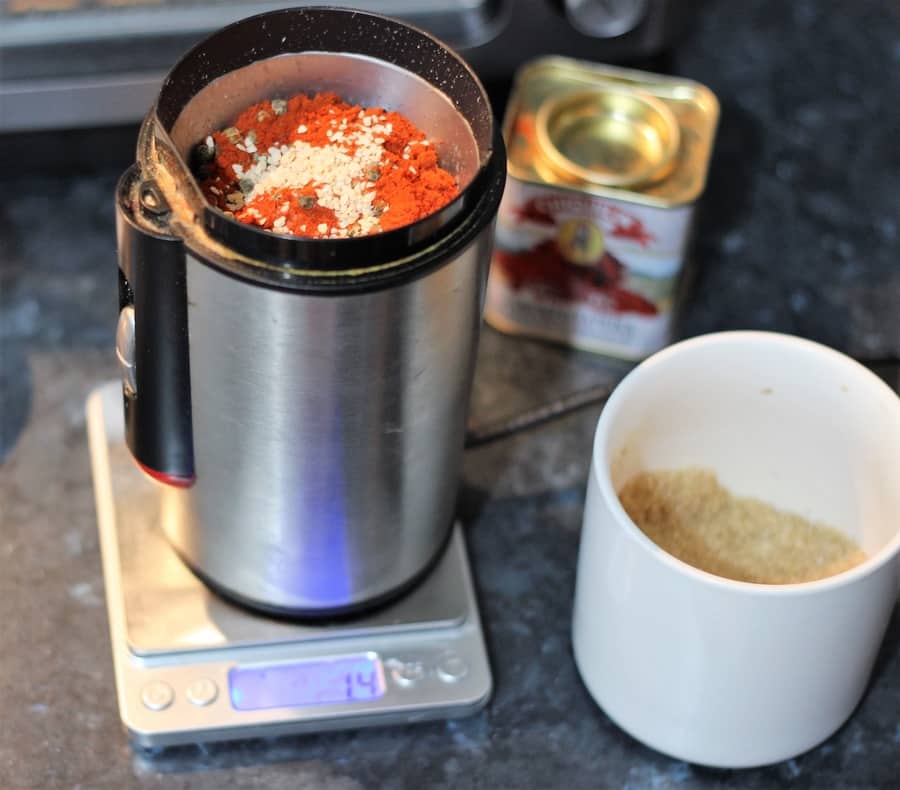
Dry salt curing involves holding moisture inside, slowing water activity to discourage unwanted bacteria, and drawing moisture out (with saturation/excess salt curing).
Equilibrium curing involves placing meat to be salt-cured in the bag; the weight of the meat measures the salt. The salt ‘equalizes’ inside the bag, the salt penetration is consistent throughout the meat.
Saturation/Excess Salt Curing
Cover meat liberally with salt and rub into crevices.
Time to Excess Salt Cure – 1 Day per 1/2 Pound to 1 Pound of Meat
Factors such as meat-to-fat ratio and density of the meat (red meat is denser than fish, for instance) – will vary the salt penetration speed.
It is the simplest way, but results can vary; I prefer to use equilibrium curing
Wet Brining Excess Salt Curing
For example, Wet Cured Cold Smoked Bacon– pork belly slab of 11 pounds /5kg (can be scaled to suit)
- 1 Gallon or 4 Liters of Water
- 250 grams of sea salt
- 125 grams (max of sugar)
- (optional) 80 grams Pink Curing Salt No. 1
Heat to dissolve ingredients in a pan and leave to cool to room temperature before brining.
Time in Brine to Cure:
- 7 to 10 days in the fridge, fully submerged in the brine.
- Some form of non-reactive weight, like clean stone, could be used to keep the meat fully submerged; you do not want it floating on top.
- For thicker cuts (over 2 inches/5 cm), lean toward 10 days.
Dry Curing – Equilibrium
2-2.5% salt to for the total weight of meat – using the dry salt equilibrium curing method; here is a guide I wrote. The total percentage includes if pink curing salt is used.
- 2.25% salt
- 1% sugar
- (optional) 0.25% pink curing salt No. 1
Time to Dry Cure = 3 days per 1″ of 2.5 cm thickness of meat.
Place meat in a bag in the fridge for the allotted time.
2. Form Pellicle on Exterior
Binding the proteins on the outside of the meat will allow the smoke vapor to attach to the meat more easily.
For some reason, many online guides do not cover this. The pellicle is essential to developing a good smoke flavor. This also relates to the environment inside and outside the smoker, which I’ll discuss.

Leaving the cured meat uncovered and hanging overnight in a relatively cool area achieves this; no insects or some protection (under 15°C/60°F) may be needed.
This can also be done on an uncovered, non-reactive rack inside the fridge.
Pellicle formation or drying the meat out before cold smoking can be done, I often do it. Since you are going to be cold smoking for long sessions, it isn’t vital so much. The meat should also start drying out in the cold smoker.
However, my preference is still to do it the same way as hot smoking pellicle formation. After curing, place in the fridge uncovered overnight.
3. Setup Cold Smoker
My target is always – Under 20°C & 65-80% Humidity
Having a thermometer showing the temperature in this smoking chamber is always useful.
The actual smoke process is much more straightforward with cold smoking compared to hot smoking in some ways. I think it’s straightforward if you have your basic factors, which are:
- Reliable cold smoker – pellet tube, smoker generator, maze smoker etc.
- An enclosed area where the meat or food is, adjustable vents ideally
4. Hang, Cold smoke and Monitor
Once the smoke enters the area, it’s pretty straightforward. A thermometer can ensure the temperature is under 25°C or 86°F. If I’m using an electric cold smoker attachment or smoke generator, I don’t usually bother. I wait until the temperature outside is under 25°C / 77°F.
You shouldn’t have any issues if you have fully cured the meat and it’s cool, winter, or maybe nighttime.
5. Cover, Rest and Refrigerate
It’s an extended process, but if you want to take breaks, you can wrap the meat up and put it in the fridge for the next session. Cold smoking requires rest every 4-8 hours, especially for pork and red meat.
When cold or hot smoked food is refrigerated, the smoke flavor intensifies once it is completed. This is even true when you cook/smoke a sausage and leave it in the fridge overnight.
I find it sometimes hard to put it in the fridge; it gets devoured too quickly!
Expert Tips
For cure meat to be cold smoked, these are the most important points I can give you from what I have learned:
- Make sure you have fresh, good, high-quality meat
- Weighing before curing and working out the finished weight
- Make use of adequate refrigeration when processing meat
- Accurately salt cure or salt wet brine the meat
- Choose wood that won’t be too strong
- Have a smoke generator or cold smoking device for consistency
Keep Your Cold Smoking Out of the Sun—The sun can heat a chamber up, so I always try to find a shady spot to smoke cold on the porch. The sun will swing across the sky, so consider this when positioning your cold smoking session.
What I learned about cold smoking is that ‘less smoke is better than too much.’ Over the decades of making cold-smoked bacon, I’ve reduced the cold smoking hours, with 6-8 hours for many styles of salami or bacon.
I’ve experimented with long 30-50-hour cold-smoked meats and visited/tried Montenegrian-style cold-smoked dry-cured hams, which are 30 days plus of cold smoking. These are very well preserved, though there is a point where the smoke overpowers the meat flavor completely.
Weight Loss with Cold Smoking
It seems to vary between meats, especially fish like trout and salmon. As soon as fish are out of the water, they start losing weight, so the weight loss you want to achieve varies.
Since cold smoking is just another form of drying.
I aim for at least 15% less than before curing for fish. Many commercial smokehouses target 30% weight loss.
For Cold Smoked Bacon (I wrote an article about that here), I aim for at least 25% weight loss. I have generally seen 20-30% in books as a guideline.
When the humidity is high, the cold smoking will take a lot longer, but unless you’re using commercial equipment, weighing the meat is the next best thing to work out how effective and how long the cold smoking should be for.
This book covers all the aspects of cold and hot smoking, so I got the idea to think more about humidity from it.
What Does Cold Smoking Mean?
Cold Smoking preserves and flavors food. It is achieved through airflow and a temperature below 30° C/86°F. Humidity is also vital for cold-smoking meat. If meat is being cold-smoked, it must be fully salt-cured before cold-smoking.

Tom Mueller
For decades, immersed in studying, working, learning, and teaching the craft of meat curing, sharing the passion and showcasing the world of charcuterie and smoked meat. Read More

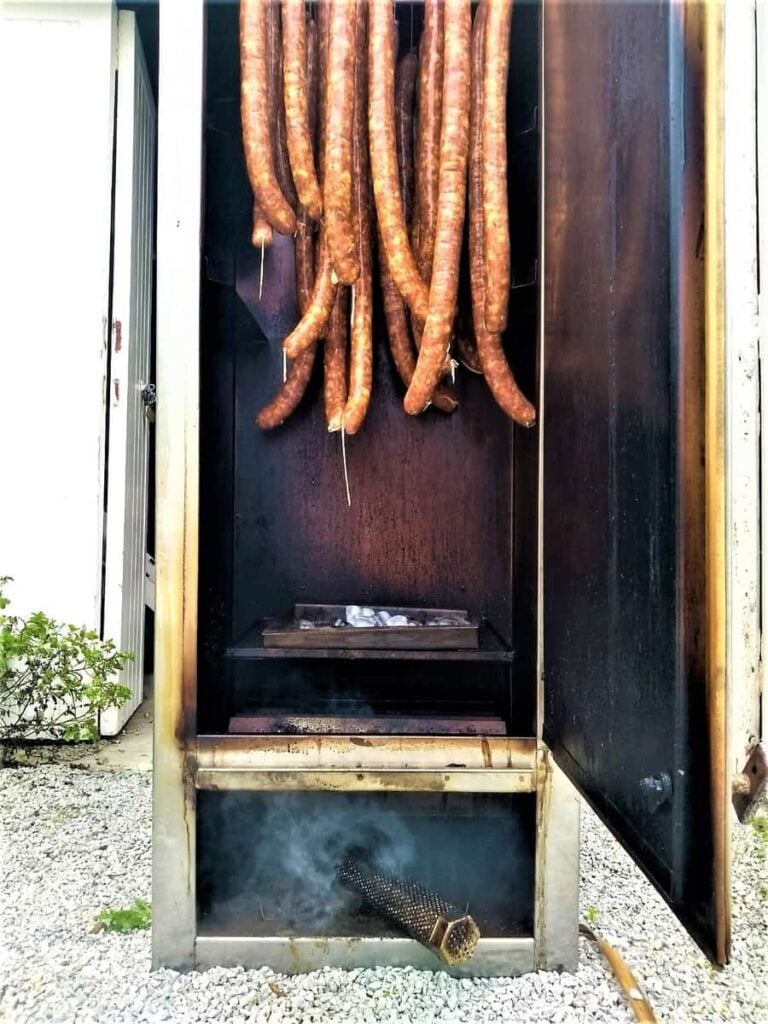
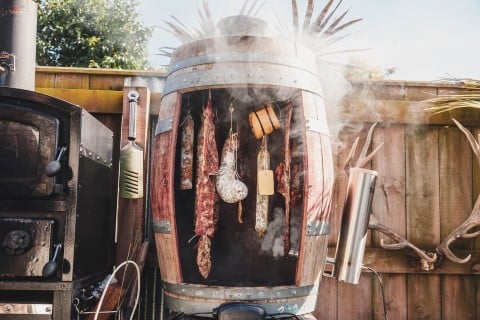
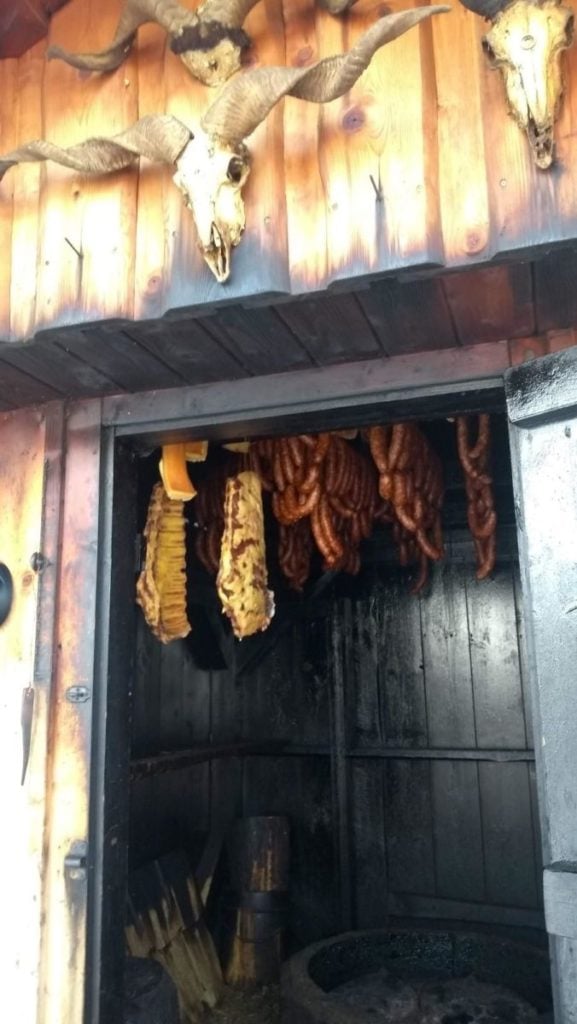
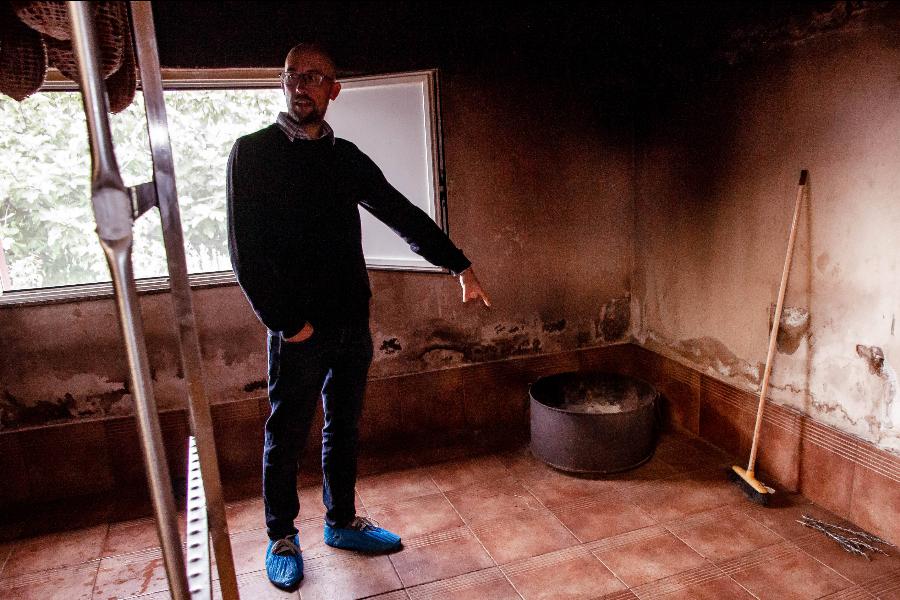
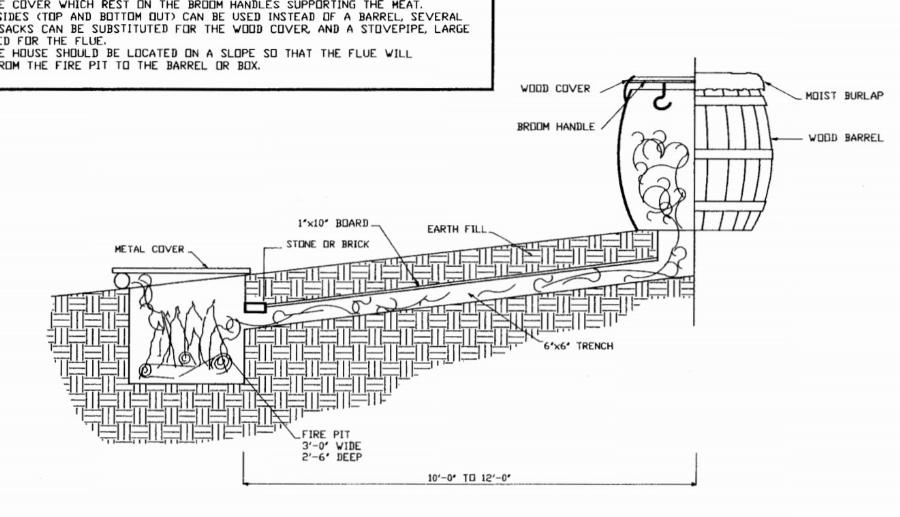

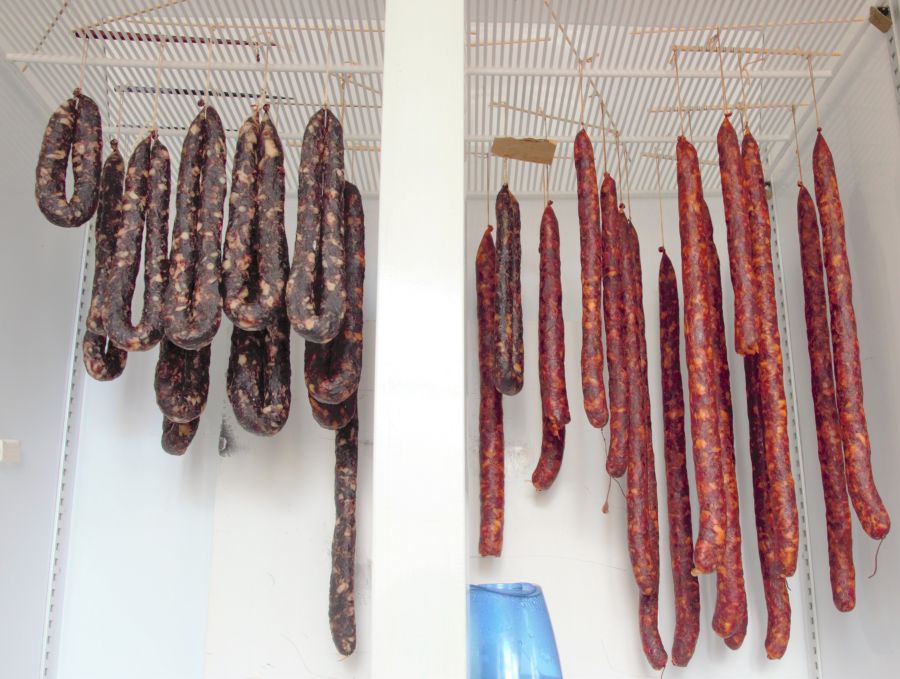

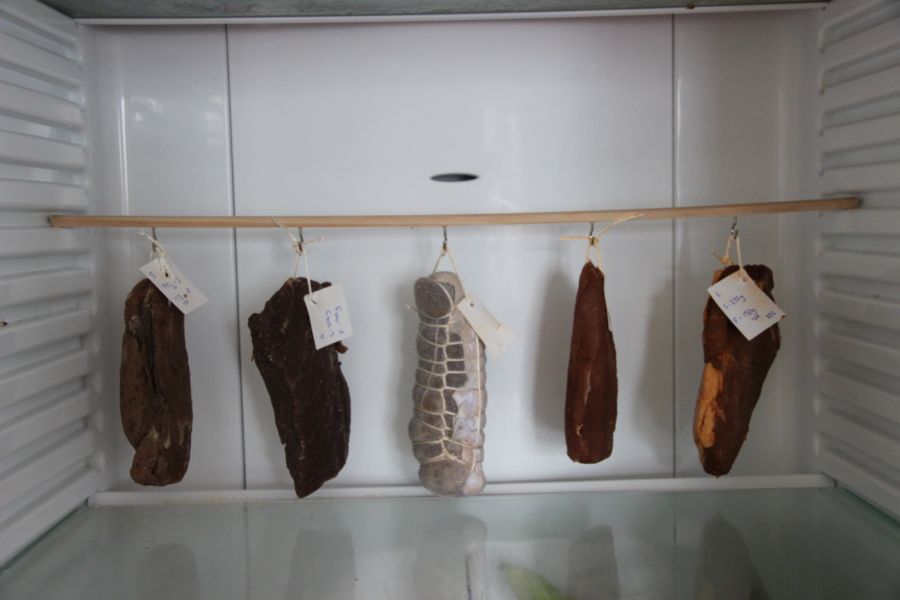
I’d love to know more about Venturi vs maze/tube
Hey Julia, it’s a super broad question!
The biggest thing is the pump from smoke generator means control over how much smoke with the variable pump. I see from you email you’re in Australia?. Google https://smokai.com/ – to read about a venturi smoke generator
If you haven’t read, I wrote this about pellet tubes – https://eatcuredmeat.com/how-does-a-smoker-tube-work-cold-or-hot-smoking-guide/
Hi Tom,
I made a smoke generator out of an old 1 gallon propane tank and use an old CPAP machine as a pump to pipe in the cold smoke into my vertical propane smoker (without gas). The CPAP’s air pressure is much more proficient than a portable aquarium pump. I place the briquettes in a minion method and add the wood chunks. I get at least 8 hours of smoke before I need to add more briquettes and wood chunks. It works really well for cold smoking salmon.
Awesome! DIY invention. Sounds very smokey!
I don’t generally smoke over 5-6 hours in one session, so a longer cold smoke isn’t needed.
I love your site I built a new smoke house and plan to use a lot of your records thanks Steve B from Missouri. Have you ever cold smoked a chicken?
Heya,
Nope – but as long as the meat is fresh (chicken seems to develop unwanted bacteria faster than red meats. As part of the charcuterie whole muscle online video course I’m doing, I’, going to be included a cold smoking ebook (currently writing it). Trying to go in-depth as much as possible. I’ll also make the cold smoke ebook available separately, I’ll be emailing out when its done to all emails on this page.
Cheers
Tom
Would it be possible to build a smoker or cold smoker using the exhaust vent from the pellet wood stove in my basement to pump smoke into an enclosed smoker box? any ideas would be greatly appreciated
Definitely! I would think so! Basically, cold smoking is pumping smoke from 1 area to another, or just keeping the smoke under 30C or 86F , but I prefer under about 15C or 40F. Moisture and Airflow helps too!
I’ve seen cold smokers made from fridges, barrels, any wooden box, beehives, gas grills, kettle grills, pellet smoker grills – really it’s just a chamber with airflow through it! 🙂
All th ebest,
Tom
Hello Tom!
I,ve made my own Venturi type smoker. For generating a lot of smoke it´s very effective and the smoke is also cold and that is good because I want to cold smoke. However the smoke is thick and white and the food I´ve smoked so far tastes terribly bitter. The Wood I´ve used is Cherry and it makes the food taste great in my hot smoker. What is your experience of Venturi type smokers, can you get them generating any other smoke than thick White? I´ve looked at a lot of clips when people use them and they all seem to make only thick White smoke.
All the best Patrick.
Nice Patrick! Yeah the theory behind cold smoking is ‘light’ with good airflow and high humidity. So fo me, I always just have a whisper of smoke.
My venturi smoker has a variable airflow pump (fish tank air pump basically). This allows me to choose the smoke amount!
I learned many years ago less smoke is better than. Open up the chamber/area more and go slow on that smoke! I’m going to have a cold smoking ebook as part of the online dry cured course coming out in a few months, here that link. Cheers Tom
Thanks Tom! I have smoking chamber with minimal airflow and a lot of smoke from my smoker. So now I have some things to start fixing. Graet tips, looking forward trying them out!
I´ll look into the course and ebook to, sounds great!
No problemo! cheers Tom
nice article Tom im going to cold smoke a twice smoked ham for xmas my 1st go at cold smoking if i cold smoke cheese or peppers at the same time does it affect the flavor or should they be done separate thanks keith
nope, not in my experience, here’s to the silly season!
Hi Tom, a lot ofGood information here. I am planning on getting your book it is sure to help me has just this article long did. I do have a question: I want to cold smoke Loma, I wish for it to hang for approximately 14 days give or take. It will have a dry rub with curing salt and regular salt to create equilibrium. My question is, how many days should I put this in a cold smoker to smoke and then remove it, to finish the drying process in a 70% humid 50 degree Environment inside the house, that will not be smoking? I want to get some good smoke flavoring but I live in Michigan and it’s pretty cold out so I think cold smoking for a few days?? And then hang inside? Not sure if you’ve had any experience with this but you may have with your years of knowledge please share. Thank you the time you took to write extensively to be honest.
I share my cold smoked bacon recipe in the online course, I like 6-8 hours for a lighter smoke. You could try 4-6 hours, let it rest overnight. Of course, it depends on the thickness of the smoke vapor, airflow etc… it just takes experience with this craft! 😉 Many of bought the ebook and are happy with the content, Cheers T – Like dry curing, there is much more then just a recipe to follow!
Hi, loved the article and the site, congratulations! I’m making homemade pastrami (it’s curing in my fridge right now) and I plan to finish it off in the slow cooker and cold smoke it to add flavor (I live indoors, so I’m using a smoke gun). Should I do it while it’s cooking or only afterwards? Or maybe both?
Hey there, to be honest I haven’t used a smoke gun. I’m using other methods involved with combustion!
If it was me, using this infusion method – I would be doing it after cooking. Seems the infusion of smoke is lost if done before cooking. After smoking, you should ‘rest’ in a container/bag/cookware overnight. This may enhance the smoke flavor and let it permeate. Cheers Tom
Hello, do you think I can use the same cold smoker for Fish and Meat? Do I risk getting the fish taste or flavors pass onto the meat?
Regards
Of course that’s ok! Been doing that for like 20 years!
I converted an old fridge into a smoker box and used a water heater with 2 electric plates dropped in it where i place buckets of chips , a 12 foot 6″ galvanized pipe joins the two so I can get smoke at 75f. I’ve made a salt heavy teriyaki brine to soak my moose meat for 12 + hours in an attempt to make moose jerky. My question is since jerky is drying the meat and smoke is just a flavour enhancer / preserver should I try to place a fan in the fridge to promote air movement
If it was me, I would want some airflow also for jerky, some form of acidity can also be used to preserve, like the ‘biltong’, which south Africans are known for. Acidity has a denaturing effect like cooking.
Also, if it was me thickness of the meat will be a big factor in drying (something like 3 days per inch?), also what salinity the salt brine is of course! hope it works out! Cheers Tom ps. after a 10-20 hr of smoking max, I would be just letting it dry. The hard part of wet brining is knowing that you have fully salt-cured it evening through the meat. More recently I have been injecting meat with equilibrium brine to speed things up (just makes lots of holes!)
Hi Tom
I still can’t find an answer to my question. I had the pork belly for bacon in salt brine for ten days. That’s my father’s advice. But now, I don’t know how long, how many sessions to keep cold smoking and what are steps between and after smoking. Where and how to dry the bacon? Thank you.
Hey, too many variables, it’s not quite that straightforward, for ‘saturation curing’ 1-2 days per 2 lbs/1kg, it depends on the temperature you’re curing, and also the fat/meat ratio (less water in fat).
This is the reason why I am producing a video bacon course right now, should be done by xmas I hope.
I cold smoke for 4-8 hours my house bacon, dry bacon before cold smoking. Also, hope you have exp cold smoking, its quite a few tips. Get my free ebook on cold smoking if you haven’t from the menu.
All the best,
Tom
Like some of the other commenters, I’m curious about doing this in an apartment without a proper smoker. Do you think it would work to cure fish/meat/whatever in a vacuum sealed bag under weights for a week, then pump smoke from a smoke gun into the bag and close it off for a day or so to really infuse the flavors?
Or is the point to let it smoke + oxidize/dry a bit at the same time?
Thanks!!
I think I wrote on smoke guns, the ‘vapor’ doesnt really stick at all to the meat. It’s used in some restaurants as the finally stage. But its really nothing like using ‘real’ smoke. My suggestion, which I have been testing with my new 5 ways to do bacon masterclass – using liquid smoke, buying good stuff means its the condensation from a smoker basically. Putting this on during the curing process is definitely what I would be doing!
You mentioned earlier in the article about humidity with cold smoking. Can you throw a good humidity level to keep if your smoking for like 3 weeks (suho meso). Also is there a low temperature to be aware of? Keep it above freezing? Read something about a dew point once. Thanks
I had to google suho meso! it sounds a lot like pastirma or basturma I’ve made.
Ideally depending on where in the world you are at nighttime is often when humidity is more like 70% – and better for cold smoking. (basically you want conditions similar to dry curing…)
I’ve cold smoked from above freezing to about 15C/60F. For longer cold smoking, I guess you could add a humidifier. Remember cold smoking is really just drying the meat with smoke around it!
3 weeks, is often more like once per day for 3 weeks, not 3 weeks 24 hours from what I’ve learned. Cheers
Is it ok to smoke cheese and steak at the same time?
cold smoke? I do! that wonderful smoke is anti bacterial/fungal etc… Cheers T
Thanks for this article! Just discovered your you tube channel as well. I’m new to cold smoking but have made some delicious cold smoked salmon with WSM and a maze smoker, now want to do white meat fish i.e. herring. When I see videos and articles on herring or cod, they indicate after finishing cold smoke, you still have to cook, poach, pan fry? With salmon, I cured 24 hrs, rinsed (soaked actually) then cold smoked 80 F about 18 hrs then chilled, sliced and ate, nobody got sick. Just brined some pollack, rinsed, then smoked 18 hrs, looked great but I did additional hours at 200 F to be safe, now I have jerky. Is there something about salmon that’s unique? Would appreciate any help. All the best, Cheers!
interesting, I haven’t done herrings or smaller oily fish! but i am waiting for the weather to clear up to get some! its been one my list for a long time
salmon is often salted and dried
herring, anchovies, etc is often salted, cold smoked and oil preserved (probably a reason for that)
salt and drying these small fish could make them too intense in flavor! (i have had that with some wild game, like certain ducks or geese)
If its salt cured properly then it just comes down to drying for preservation, but with salmon gravlax or lox – often its not dried, just consumed inhibited with salt form my exp
All the best,
T
pollack is lean, salmon is fat, this will produce diff outcomes too, fattier fish better for smoking!
I am trying to start cold smoking. Need a lot of knowledge so I start right.
Great, hope what I write helps, All the best, Tom Mueller –
Check out the free pdf cold smoking guide too
What about cold smoking in contrys that the whether is between 28c to 38c? Is it dangerous that the meet can go bad? I hard sam guys that did a cold smoking in temperature of 40c. Is it possible?
Hi, Difficult- non-meat – maybe. Meat no way. Fish starts cooking around 30c. I had a guy comment a few years ago that used a fridge. And pump cold air through the fridge. Or if you ordered a plug in controller, you could cycle the fridge on and off to be around 10-15C. With cold smoker pumping smoke in, and some airflow out of fridge also.
You environment is just not for it. In South Africa, Vinegar and Salt is used to cure/denature meat then dried in heat. Acidity can help alot for preservation. All the best, Tom
Hi. Great article it was a pleasure to read it.
2 thins I’d like to know please.
1. What about places that the whether there is 28c up to 38c? Do you recommend not doing cold smoking?
2. I heard from someone that he cold smoke at 35c and even 45c. Is it dangerous?
1. Answered already
2. Yes dangerous, bacteria growth is rapid between 35c and cooked meat temps!
We have a field stone smoke house 5 foot wide 8 feet deep 6 foot side wall that i need to reroof it . i was thinkn of using smokey joe smoker once i fix it up we live in Grafton Wi . the old barn is 1882 thinking it has to be around same year
Sounds like a great setup, the traditionalists in Europe like to have adjustable vents in some way. Smokey Joe is like a bullet or drum style from memory.
I use Summer Sausage seasoning with cure. I’ve got a 55 gallon barrel that I build a fire in and I ‘ve got a 4″ pipe in top of the barrel 2 foot long running to the 55 gallon barrel on top for the smoke to go in, and I have a hole for the smoke to come out.in front of top barrel and I smoke it for 6 hours and the top barrel never gets to hot you can put your hand on it. And I set and watch it and make sure it doesn’t stop smoking. Then I let it hang for 3 or 4 weeks til it gets the hardness that I want on the sausage is this safe?
Guess it depends on temp control and curing accuracy. Hygiene, meat quality – freshness and how it was handled. Environmental conditions also.
Tom
We plan to host a 4H ham project on our farm our smokehouse needed replacing which we plan to do initially we will have 50 participants each trimming and salting a fresh ham we anticipate more participation with this in mind any information with a simple smokehouse design and a Venturi smoker you could pass along would be appreciated. We’re confident this will be an annual event that said without breaking the bank any ideas you may have would be greatly appreciated.
Thanks in advance
what style of ham? whats the recipe? – depending on the style is influences all the thoughts I have for you – all the best, Tom
I have been told that my freshwater trout and salmon from Lake Superior and Lake Michigan should not be cold smoked. I have very frequently hot smoked both with excellent results. However, I really want to try Chinook salmon and steelhead lox or cold smoked. I generally wet brine in salt and sugar for 12 to 20 hours. Then, I rinse and dry until pellicle forms. I have a Bradley smoker which allows me to unplug the heating element. Should the salmon and trout be safe if I cold smoke it for eight hours?
I can’t comment on the quality of trout or salmon in a lake.
But for cold smoking, its not about how much cold smoking, the cold is a just one aspect of the preservation. Its the salt penetration and drying. The salt inhibits the meat and slow the bacteria moving in it, drying also has a function similar to this, less water in meat – less chance of spoilage. All the best, Tom